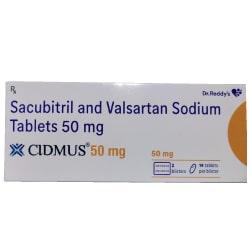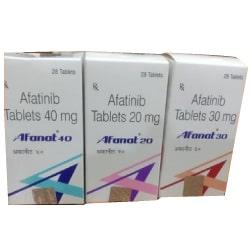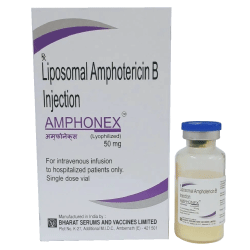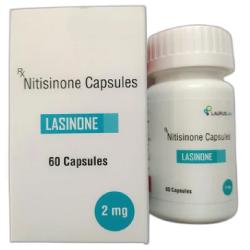Description
Cidmus 50 mg Tablet is a combination of sacubitril, a neprilisin inhibitor, and valsartan, an angiotensin II receptor blocker, and is used to reduce the risk of cardiovascular death and hospitalization for heart failure in adult patients with chronic heart failure. Sacubitril + Valsartan Benefits are most clearly evident in those with left ventricular ejection fraction (LVEF) below normal.
This therapeutic drug is also used for the treatment of symptomatic heart failure with systemic left ventricular systolic dysfunction in pediatric patients aged 12 months and older. This treatment reduces NT-proBNP and is expected to improve cardiovascular outcomes.
Dosage and Side Effects Sacubitril and Valsartan:
The recommended dosage of Cidmus (Sacubitril and Valsartan) tablets typically depends on the patient’s condition and medical history. However, the usual starting dose is 49/51 mg twice daily, which can be increased to a target maintenance dose of 97/103 mg twice daily, as tolerated by the patient. Patients must follow their healthcare provider’s instructions regarding dosage adjustments and any specific recommendations tailored to their individual needs.
The most common side effects of Sacubitril and Valsartan tablets are hyperkalemia, hypotension, cough, dizziness, and renal failure.
Warning and Precautions Sacubitril and Valsartan:
- Cidmus tablets may cause symptomatic hypotension, especially in patients with salt depletion, volume depletion, or receiving high doses of diuretics. Blood pressure should be monitored regularly, and dose adjustments may be necessary.
- Use caution in patients with renal impairment, as Cidmus tablets can lead to renal dysfunction, including acute renal failure. Monitoring of renal function is recommended, and dose adjustments may be necessary.
- Sacubitril and Valsartan tablets may cause hyperkalemia, especially in patients with renal impairment, diabetes mellitus, or receiving potassium-sparing diuretics, potassium supplements, or salt substitutes containing potassium. Serum potassium levels should be monitored regularly, and appropriate measures should be taken to manage hyperkalemia.
- Angioedema, including swelling of the face, lips, tongue, and throat, may occur with the use of Cidmus tablets. Patients should be monitored for signs of angioedema, and treatment should be discontinued if angioedema occurs.
- Sacubitril/Valsartan tablets can cause fetal harm when administered to pregnant women. Pregnancy should be avoided during treatment with these tablets, and effective contraception should be used in women of childbearing potential.
- Use caution in patients with hepatic impairment, as Sacubitril and Valsartan can lead to hepatic dysfunction, including liver failure. Liver function tests should be monitored regularly, and dose adjustments may be necessary in patients with hepatic impairment.
FAQ's
What is Cidmus?
Cidmus tablet is a medication that contains a combination of two active ingredients: sacubitril and valsartan. It is used to treat certain types of heart failure in adults.
How should I take Sacubitril/Valsartan?
Take Sacubitril/Valsartan tablet once daily, with or without food, at the same time each day, as directed by your healthcare provider.
How can I store Sacubitril/Valsartan?
Store Sacubitril/Valsartan tablets at room temperature between 68°F to 77°F (20°C to 25°C) in a tightly closed container away from light.
How much does Sacubitril/Valsartan cost in India?
Sacubitril/Valsartan 50mg tablet cost in India is reasonable and can vary. To procure this medicine legally, you can call us at (+91) 8130290915, TOLL-FREE: 1800-889-1064, Or Write us at info@indiangenericmedicines.com.
Can Sacubitril/Valsartan be used while I’m pregnant?
Sacubitril and Valsartan tablets may be unsafe if considered during pregnancy. Talk to your doctor about the right way to help control your condition if you want to become pregnant or during pregnancy.
Can Sacubitril/Valsartan be used while breastfeeding?
Breastfeeding is not recommended while on Sacubitril/Valsartan tablets. Talk to your healthcare provider if you are breastfeeding or intend to breastfeed.
Where can I get Sacubitril/Valsartan at the best Price?
Order Sacubitril/Valsartan tablets at the best price today. We request you to Call/WhatsApp us at (+91) 8130290915 or dial our TOLL-FREE Number: 1800-889-1064 or Write us at info@indiangenericmedicines.com. We are committed to providing you with the best Sacubitril/Valsartan price from India. That is why we’ll match the cost/price of any suppliers/distributors in the market who require a medical prescription.
Is the Sacubitril/Valsartan available in India?
Sacubitril/Valsartan tablet is a (prescription drug, doctor-prescribed medication, or health care professional-prescribed medicine) pharmaceutical drug that can be legally dispensed against a medical prescription. Sacubitril and Valsartan can be made available through the network of authorized distributors in India. (Bangalore, Mumbai, Ahmedabad, Kolkata, Chennai, Hyderabad, Delhi, Pune, etc.).
Can You Send the Sacubitril/Valsartan to Foreign Destinations?
Buy generic Sacubitril/Valsartan tablet online at the best/lowest price from a leading supplier. Indian Generic Medicines can assist in the delivery of Sacubitril/Valsartan; the doctor-prescribed medication to the UK, South Africa, Kazakhstan, Canada, Australia, Philippines, the USA, Saudi Arabia, Thailand, China, Hong Kong, Uzbekistan, Zambia, Pakistan, Kuwait, Sri Lanka, Sweden, UAE, Turkey, Afghanistan, Malaysia, Singapore, Qatar, Japan, Nepal, and many other countries.
What is the procedure for buying Sacubitril/Valsartan from Indian Generic Medicines?
Patients can fill out the order form or send mail to info@indiangenericmedicines.com. Patients can also send WhatsApp messages to +91 8130290915 or can dial the TOLL-FREE Number: 18008891064. We will reply ASAP with the details of the Sacubitril/Valsartan price and the procurement procedure.
Note:- The order will be confirmed only after the valid receipt of the prescription from the Physician.
Is it safe to buy Cidmus (Sacubitril/Valsartan) online from India?
Yes, one can buy Cidmus (Sacubitril/Valsartan) online from India-based Indian Generic Medicines (IGM) if this medication is not (yet) registered or is unavailable in their respective country. We can facilitate the supply of Sacubitril/Valsartan tablets through legal channels.






